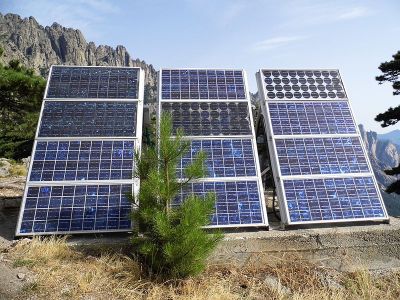Nanotechnology to harness infrared light

Solar panels. fot. By Mathieudu68 (Own work) [CC BY-SA 3.0
EU-funded scientists are using plasmonic nanocrystals (NCs) to shift the light-harvesting spectrum of solar cells to the near-infrared region.
Plasmonics is an exciting and rapidly expanding research field. Of
particular interest is the localised surface plasmon resonance (LSPR)
observed in noble metal NCs that leads to strong light scattering and
enhanced light–matter interaction. However, LSPR in such cases is
restricted to visible wavelengths.
Recent studies showed that semiconductor NCs with reduced copper
content exhibit strong LSPR in the near-infrared range of the
electromagnetic spectrum. This exciting finding allows peak shifts to
higher wavelengths compared to the visible ones, and thus semiconductor
materials to be transparent near the LSPR wavelengths.
Based on this, the EU-funded project 'Near-infrared semiconductor
plasmonic nanocrystals for enhanced photovoltaics' (NIRPLANA) focused on
synthesising and incorporating plasmonic NCs into thin-film
photovoltaic cells. Project advancements should pave the way for
fabricating solar cells that capture infrared radiation that most cells
ignore.
Scientists developed different plasmonic NC materials, with
covellite being the most promising candidate for photovoltaics
applications. Control over their thickness and diameter allowed tuning
the LSPR amplitude that was high around wavelengths of 1 micrometre.
Three different materials for the absorber layer were also
synthesised. The absorption edge of lead–sulphide NCs proved to be
similar to the LSPR amplitude of covellite NCs. More suitable plasmonic
NCs need to be developed for cadmium telluride.
Scientists replaced the long-chained organic ligands attached to the
NC surface during synthesis by shorter ligands to achieve efficient
charge transport throughout the solar cell. In addition, they
established a suitable method to prepare quantum dot thin films with
inorganic sulphur ligands for integration into quantum dot solar cells. A
procedure was developed to prepare lead–sulphide NC solar cells in air,
with conversion efficiencies of approximately 0.5 %.
Project findings can inspire new directions in NC synthesis,
processing and applications in solar energy harvesting. Capturing a
broader spectrum of light, NC solar cells have the potential to offer a
viable low-cost alternative to current solar cell technologies.
published: 2015-03-23